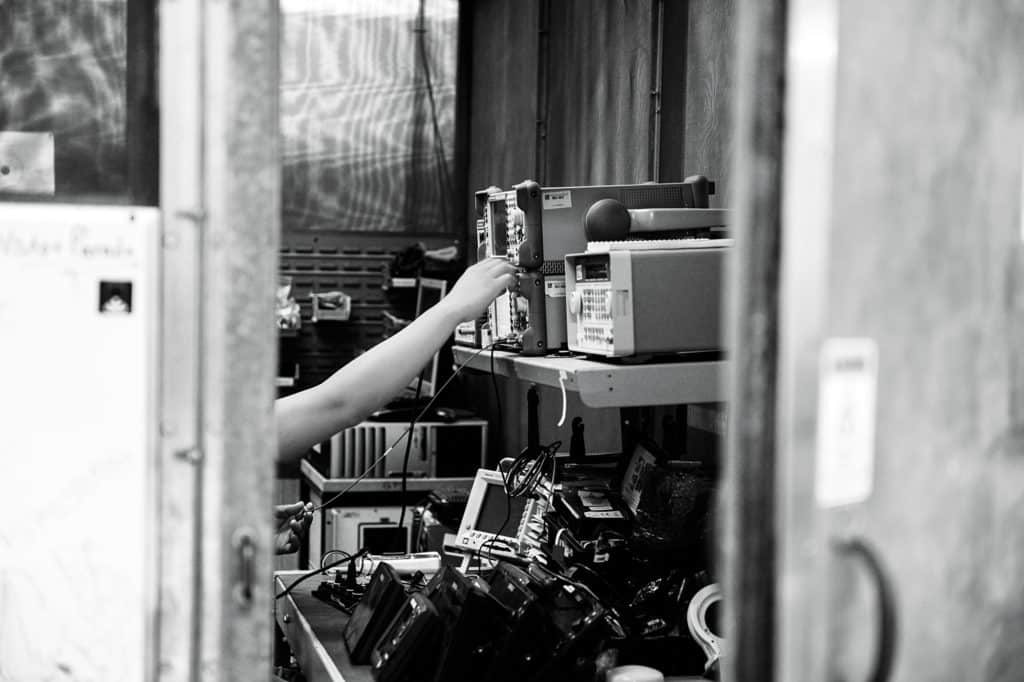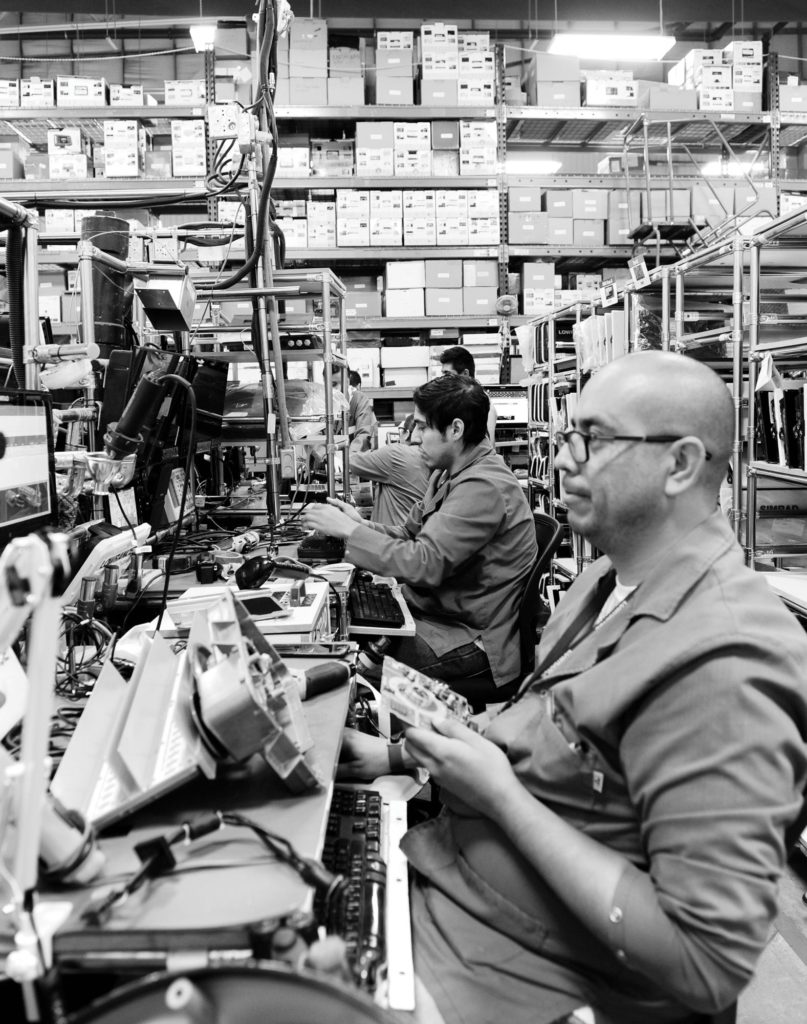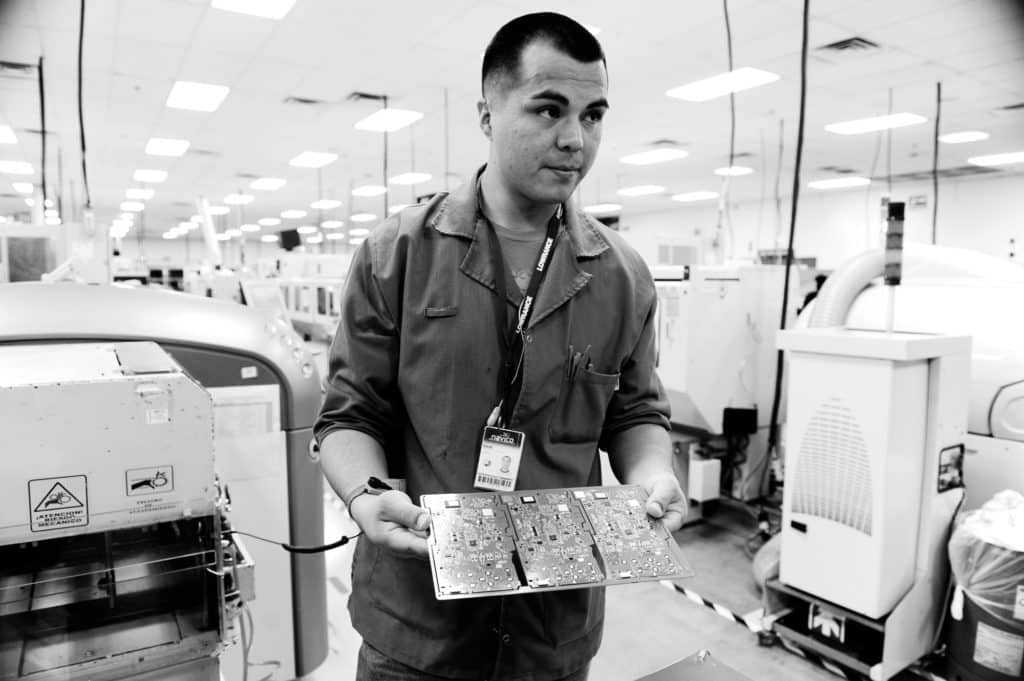
Mechanical rollers guide printed circuit boards down Navico’s production line at its factory in Ensenada, Mexico, sending them toward a pick-and-place machine that houses what looks like a 120-barrel Gatling gun. Instead of hurling hot lead, the machine’s nozzles quickly rotate and momentarily dip down—typewriter style—to place microchips onto the double-sided circuit boards. Seconds later, the machine guides the boards down the line as the next ones enter the shooting gallery, bound for assembly, exhaustive testing, packaging and then random batch-testing before shipping out. The world will see them as finished B&G, Lowrance and Simrad products.
This tightly controlled process involves a blur of high-tech machinery that enables this factory and its skilled workforce to produce up to 10,000 completed boards per day. And the boards will see service on waters around the globe.
B&G, Lowrance and Simrad were founded in 1956, 1957 and 1947, respectively. They merged in 2006 in a deal that created parent company Navico, based in Egersund, Norway, with offices in New Zealand, the UK and the United States. Collectively, the brands employ 1,800 people, and the merger created scales of economy and efficiency that allowed Navico to leverage each brand to better serve all three.
One example is the company’s Ensenada, Mexico, factory, which Lowrance built in 1993. Lowrance trained the local workforce, and following the merger, Navico expanded this facility and staff to tackle global production for all three brands.
Inside the factory, equipment is tested thousands of times before it leaves. Navico’s upstairs offices hum with activity as employees plan jobs that will be executed on the factory line.
Dynamic teamwork is what makes the place run, says Tim Tsai, vice president and head of procurement. “The electronics market changes fast, things come up fast—for example, tariffs or other market constrictors—so, as a team, we have to come up with solutions.”
I’m asked to wear a special overshirt that’s woven with carbon-fiber threads that prevent static-electricity buildup. Then I head to Navico’s R&D department, which is populated with open-air workstations festooned with miles of cables, tools, analog and digital interfaces, myriad black boxes, and countless screens. Testing stations and benches fill additional rooms. A few steps later, I’m at the quality-assurance room, where engineers are dissecting Simrad multifunction displays.
“The [quality-assurance] people also go out on the water and test the software and hardware on our Navico One test boat here in Ensenada,” says Ivan Garin, R&D manager. “And we also use external evaluators,” such as local captains and Navico-sponsored pros.

We pass Navico’s optical group en route to prototyping rooms equipped with 3D printers, a laser cutter, and a temperature- and-humidity chamber that delivers 12 test cycles at temperatures ranging from minus 40 degrees Fahrenheit to 185 degrees Fahrenheit. “We go beyond what the customer expects and what our [equipment] actually experiences,” Garin says as he leads me into a soundproof chamber with a medieval-looking machine used for drop-testing equipment.
Our next stop is the roof, with a view of Ensenada and Navico’s expansive facility. On the far end are three consoles that allow Navico engineers to simulate onboard installations, evaluate ergonomics, and test the equipment in the unflinching sunlight of Baja, California. “It’s a big advantage to be right near the factory,” Garin says. “We can check on the line, and they can use this facility.”
Back inside, I head to Navico’s machine shop, where the company builds its own tools, dies, and work- and production-line stations. Then, I’m in the returned-merchandise area. A massive shrink-wrapped package rests on a pallet as workers organize this equipment, while others dissect and evaluate it. “If it’s a manufacturing problem, they go to the engineers, show them the issue, and the engineers can make a change on the factory line,” says Ricardo Varela, vice president of manufacturing.
This focus on quality is a frequently visited theme, and synergy certainly does exist between Navico’s R&D and returns departments and the factory. But this “dynamic teamwork” is exceeded by the levels of testing, evaluation and—should issues arise—surge-style troubleshooting that exist on the factory line.
“We’ll start where the product starts and follow the process,” Varela says, guiding us to the assembly line that builds printed circuit boards. The process begins with partially assembled boards that, in this case, come as even bigger three-board panels, which are later sliced into double-sided boards.
These panels are fed into a solder-paste printing machine that uses a serigraphy-style process to deposit solder—in paste form—over the board’s contacts to accommodate down-the-line
attachments, before being fed to the pick-and-place machine. Next, each board goes to a human quality-assurance technician who reviews it and places any necessary additional componentry before feeding it into a wave-soldering machine. From here, the board enters an X-ray machine, which ensures there aren’t any solder breaches before passing it to the in-circuit testing machine.
I watch as long-fingered probes test to ensure that each node offers the correct resistance. “We test the heck out of it,” Ricardo says, adding that this single machine performs 600 tests before releasing the board.
If there is a failed test, Varela says, then each section of the factory has a core team composed of quality-assurance, industrial and test-process engineers who can stop the line and diagnose issues. Once the problem is rectified, workers then backcheck previous batches to ensure any previous hiccups are corralled. Each component, irrespective of its size, is assigned a smart card as it’s received by the factory, allowing Navico to track everything—including factory-line test results—in a central database from start to finish.

At the end of the board-building line, the completed and soldered boards emerge and are sliced along pre-perforated lines into individual boards, which are then bench-tested. Software and cartography are loaded onto each vetted board. From here, the boards are sent to final assembly, where they become part of—for example—a radar or a multifunction display.
The sonar- and display-assembly lines are where workers pre-place touchscreen-sensitive screens that are then machine-guided onto LCD displays—and where I see tiny sonar crystals being placed onto delicate crystal arrays.
Varela leads me past the submersion tanks, where sonars are tested, before we head to the packing and content-assurance room. Workers scan each part number that comprises a finished product (in other words, a display and all its cabling, mounting hardware, and literature) before boxing them up. Computers control all forward motion. If a particular product doesn’t include all the necessary part numbers or comes up shy on a weight test (think of those self-checkout lines at grocery stores), then production stops, core team members are summoned, and the faulty product is taken to the “fish market” (“because it stinks”), where the situation is evaluated.
Once packaged, wrapped and labeled, some 25 percent of all finished products are then subjected to random testing. This includes a full unpackaging, bench testing and systems test, and ensures that faulty product doesn’t inadvertently make it out the door. “We test products on every level, many times,” Varela says.
The final stop is the company’s warehouse, where incoming parts are received and stored, and where finished products are temporarily shelved. Most parts spend just one week morphing from componentry to finished products.
Varela points over to a wall covered from end to end with photographs honoring employees who have been with the company more than five years—some of them for as long as 25 years. Counting all the names and faces, I soon realize that Navico’s high employee-retention rate serves as an important final exam for a marine electronics factory that generates far more test results than finished products.








